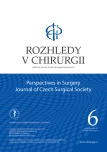Benefits of repeated CT scan in patients with neurosurgical-neurological problems in intensive care − retrospective analysis
Authors:
T. Tyll 1; D. Netuka 2; M. Bílková 1; R. Orlík 1; T. Belšan 3; M. Müller 1
Authors‘ workplace:
Klinika anesteziologie, resuscitace a intenzivní medicíny 1. lékařské fakulty Univerzity Karlovy a Ústřední vojenská nemocnice - Vojenská fakultní nemocnice Praha
1; Neurochirurgická a neuroonkologická klinika 1. lékařské fakulty Univerzity Karlovy a Ústřední vojenská nemocnice - Vojenská fakultní nemocnice Praha
2; Radiodiagnostické oddělení Ústřední vojenská nemocnice Praha
3
Published in:
Rozhl. Chir., 2018, roč. 97, č. 6, s. 262-266.
Category:
Original articles
Overview
Introduction:
CT examination of the brain is an integral part of neurointensive care. The examination, however, represents a risk for patients and has side effects. Indications for the procedure should therefore be carefully considered. The aim of the study was to analyze the indications for brain CT and the influence of its result on further treatment.
Method:
A retrospective analysis of CT examinations of the brain performed during 2010 in 263 patients admitted to neurointensive care. The study assessed whether the indication for a CT scan was due to a change in the patient’s neurological status or routine, and also whether pharmacological sedation was used. Implications of the CT scan results for the course of treatment were evaluated.
Results:
763 CT examinations of brain were performed in the study group. 81% of the patients were under pharmacological sedation at the time of the exam indication, 19% had no sedation and could be clinically evaluated. In both groups, 80% of examinations were indicated on a routine basis. More than half of all CT examination results were evaluated as no change or improvement. Two thirds of them had no impact on the course of further treatment. Results of CT scans indicated due to a change in neurological status led to a change of therapy more often than in routine indications (24.8 vs. 14.2%). The difference was even greater in patients indicated for surgery (19 vs. 8.4%).
Conclusion:
CT scans of the brain are and will continue to be a fundamental part of neurointensive care but cannot replace clinical examination, which is influenced by pharmacological sedation. Results of brain CT scans have led to a change in the course of therapy more frequently when indicated due to a change in neurological status. Rational indication of sedation can contribute to rational indication for brain imaging.
Key words:
neurointesive care – sedation – CT of the brain
Sources
- Pandin P, Renard M, Bianchini A, et al. Monitoring brain and spinal cord metabolism and function. Open J Anesthesiol 2014;04 : 13
- Stippler M, Smith C, McLean AR, et al. Utility of routine follow-up head CT scanning after mild traumatic brain injury: a systematic review of the literature. Emerg Med J EMJ 2012;29 : 528–3
- AbdelFattah KR, Eastman AL, Aldy KN, et al. A prospective evaluation of the use of routine repeat cranial CT scans in patients with intracranial hemorrhage and GCS score of 13 to 15. J Trauma Acute Care Surg 2012;73 : 685–8.
- Brown CVR, Weng J, Oh D, et al. Does routine serial computed tomography of the head influence management of traumatic brain injury? A prospective evaluation. J Trauma 2004;57 : 939−43.
- Wang MC, Linnau KF, Tirschwell DL, et al. Utility of repeat head computed tomography after blunt head trauma: a systematic review. J Trauma 2006;61 : 226–33.
- Brown CVR, Zada G, Salim A, et al. Indications for routine repeat head computed tomography (CT) stratified by severity of traumatic brain injury. J Trauma 2007;62 : 1339−44; discussion 1344−5.
- Wurmb TE, Schlereth S, Kredel M, et al. Routine follow-up cranial computed tomography for deeply sedated, intubated, and ventilated multiple trauma patients with suspected severe head injury. BioMed Res Int 2014. Available from: http://dx.doi.org/10.1155/2014/361949.
- Garrett MC, Bilgin-Freiert A, Bartels C, et al. An evidence-based approach to the efficient use of computed tomography imaging in the neurosurgical patient. Neurosurgery 2013;73 : 209−15; discussion 215−6.
- Fontes RBV, Smith AP, Muñoz LF, et al. Relevance of early head CT scans following neurosurgical procedures: an analysis of 892 intracranial procedures at Rush University Medical Center. J Neurosurg 2014;121 : 307–12.
- Waydhas C. Intrahospital transport of critically ill patients. Crit Care Lond Engl 1999;3:R83−9.
- Schär RT, Fiechter M, Z’Graggen WJ, et al. No routine postoperative head CT following elective craniotomy: A paradigm Shift? PloS One. 2016;11:e0153499.
Labels
Surgery Orthopaedics Trauma surgeryArticle was published in
Perspectives in Surgery

2018 Issue 6
Most read in this issue
- Meralgia paresthetica
- Chronic subdural hematoma – review article
- Epidural hematoma – benign or potentially malignant disease?
- Posttraumatic hydrocephalus
